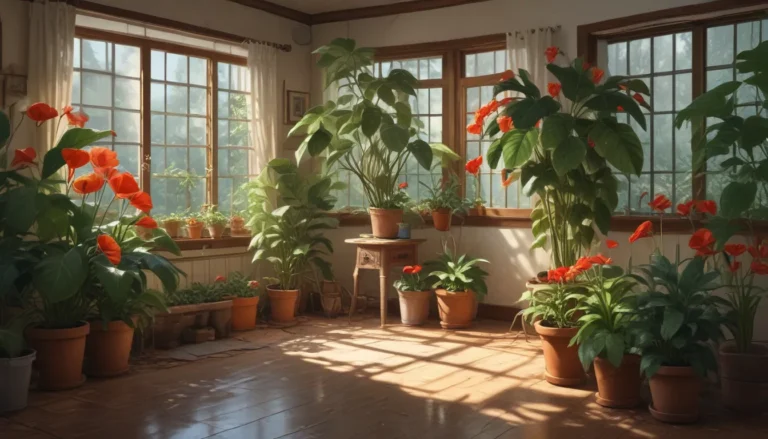A Comprehensive Guide to Growing and Caring for Ponytail Palms

If you’ve ever dreamed of having a palm tree in your home but found yourself worried about the commitment required to maintain its moisture needs, then the ponytail palm might be the perfect plant for you!
In this article, we will explore the unique features of the ponytail palm, Beaucarnea recurvata, and provide you with all the information you need to successfully cultivate this fascinating plant indoors.
So, let’s dive in and discover what makes the ponytail palm so special.
What Is a Ponytail Palm?
The ponytail palm, Beaucarnea recurvata, is not actually a palm tree, but a succulent belonging to the Asparagaceae family. Originating from semi-desert regions in southeastern Mexico and Central America, this plant is known for its distinctive caudex – a water-storing structure at the base of the trunk.
The caudex gives the ponytail palm its other names, such as bottle palm tree and elephant-foot tree. The plant features long, recurved leaves that resemble a pony’s tail, hence its name. While it resembles a tropical palm tree, it thrives in dry conditions similar to those preferred by cacti and other succulents.
Cultivation and History
The ponytail palm was first discovered in Mexico and later introduced to Europe in the 1800s, where it became a popular ornamental plant. Today, it is widely cultivated in the United States. However, the species is now classified as threatened in its native habitat, growing mainly in Veracruz, Mexico.
Propagation of Ponytail Palms
There are several ways to propagate ponytail palms:
- Offset Division: Separate small offshoots or “pups” from the main plant and transplant them.
- From a Nursery Plant: Purchase a potted nursery plant from a garden center or online.
- From Seed: Scarify and soak seeds before planting in a well-draining potting mix.
How to Grow Ponytail Palms
Regardless of how you start your ponytail palm, it’s essential to provide the right growing conditions:
- Soil: Use a loose, cactus and succulent potting mix with good drainage.
- Light: Place the plant in bright, indirect sunlight to prevent leaf damage.
- Watering: Water sparingly, allowing the soil to dry out completely between waterings.
- Temperature: Maintain a temperature of around 70°F during the growing season.
- Fertilizing: Apply a liquid cactus and succulent plant food at planting time and each spring.
Remember that ponytail palms are slow-growing plants that prefer to be root-bound. Repot only when the roots are extremely crowded.
Growing Tips
Here are some tips to help you successfully grow a ponytail palm:
- Use a loose cactus and succulent potting mix.
- Provide bright, indirect sunlight.
- Water sparingly and fertilize at planting time and each spring.
- Repot only when necessary.
Pruning and Maintenance
Ponytail palms do not require regular pruning. However, if the leaves or tips turn brown, you can trim them back to improve aesthetics. Monitor moisture levels and fertilize annually to keep the plant healthy.
Where to Buy Ponytail Palm Houseplants
You can find potted ponytail palms at nurseries or online retailers. When purchasing a plant, ensure that it is potted in a well-draining container and transplant it into suitable soil upon arrival.
Managing Pests and Disease
While outdoor plants are less susceptible to pests and diseases, houseplants may encounter issues such as mealybugs, scale, and spider mites. Treat infestations with organic neem oil. Watch out for diseases like bacterial leaf streak and stem rot, especially in humid environments.
Quick Reference Growing Guide
Plant Type: Evergreen succulent
Flower/Foliage Color: Male: cream; female: pink / green
Native to: Central America and southeastern Mexico
Tolerance: Drought
Hardiness (USDA Zone): 10-11
Maintenance: Low
Exposure: Bright, indirect light
Soil Type: Gritty, sandy
Time to Maturity: 10 years
Soil pH: 6.0-7.5
Planting Depth: 1/8 inch (seed), same depth as nursery pot (transplants)
Soil Drainage: Well-draining
Height: 4-8 feet
Spread: 3-5 feet
In addition to being easy to grow and low-maintenance, ponytail palms are non-toxic to pets, making them a great choice for animal lovers.
So, if you’re looking for a striking yet undemanding plant to add to your indoor collection, consider the ponytail palm. Its unique appearance and care requirements make it a delightful addition to any home. Have you grown a ponytail palm before? Share your experience in the comments below!
If you enjoyed learning about the ponytail palm, check out our other plant care guides to discover more indoor plants to cultivate and enjoy.
Remember, the joy of growing and caring for plants is a rewarding experience that brings nature’s beauty into your home. Happy gardening!





